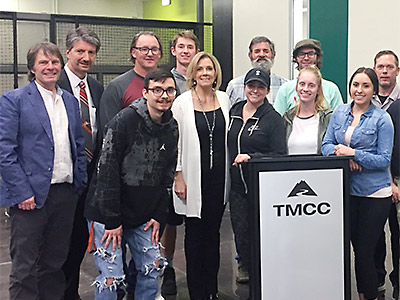
City of Reno, Councilmember Neoma Jardon spoke to TMCC students on March 12 about the City's efforts underway, and her personal goals for the Reno Homeless Project.
In Part 1: James Severt is inspired during an English 101: Composition I course, and comes up with a project to design single-unit transitional housing for individuals who are homeless. Architecture Instructor Kreg Mebust is called at about the same time by a local developer with a similar idea. Three Architecture Program classes sign on to help, and the City of Reno voices support for the project.
Architecture student James Severt’s vision is to create workable and sustainable structural designs for transitional housing—single-unit structures to help individuals have a dignified place to live as they get back on their feet.
His vision is that each residence is small and easy to manage, with interior electricity and includes furnishings such as a desk, bed, cabinetry, and storage. The units will each meet fire code, and groups of units will be close to a community shower facility, in addition to a clothes washer and drier.
Severt views the units’ purpose as a respectful temporary home to be used for a few weeks or a month, and then the unit is cleaned and turned over for the next tenant.
Truckee Meadows Community College Instructor Kreg Mebust says that an architecture project must first begin with research—establishing a good understanding of the people who will live in a structure, and the land with which the structure will interact.
Research began slowly, as students and instructors located experts in the region on the causes and characteristics of homelessness. Working with Mebust, student James Severt who is functioning as Project Manager to fulfill the requirements of his architecture Independent Study, found specialists from four community groups.
“The architecture project is like a slow-moving train that’s hard to get started but will move pretty well when it gets moving and be hard to stop once we really get going,” he said.
Experts Visit Classes
Staff members from community groups and public agencies volunteered to come speak to architecture students at the William N. Pennington Applied Technology Center:
- Acting in Community Together in Organizing Northern Nevada (ACTIONN), J.D. Klippenstein, Executive Director
- Catholic Charities of Northern Nevada, Yvette Myers, Director of Housing
- Eddy House, Michele Gehr, Executive Director
- Washoe County Department of Building & Safety, Don Jeppson, Director
“We had guest speakers on Feb. 5 and they did a presentation, including building codes that need to be followed,” Severt said. “All four speakers brought forth valuable information for our continued research into creating a working model or models to present to the City of Reno and TMCC community.”
Three of the presenters shared information with the students that surprised them about the great number and wide variety of causes for homelessness.
The students learned that some individuals choose to be homeless as a lifestyle—the habitual homeless not looking for a solution. But for the most part, people do not choose homelessness and are suffering, eager to find a permanent home. These situations include those with mental illness, the elderly, individuals coping with drug addiction, and those who have run into compounded instances of bad luck. In addition, families that are experiencing poverty find it difficult to make the high rent payments in this region.
“There are people in transition who are just looking for work,” he said. “If you can get young adults 24 years old or younger back on their feet, not in the homeless category, there is a 100 percent chance that they will never be homeless again. They will also be the ones that come back and help in the future.”
Speakers explained that individuals under the age of 24 who have been homeless for a while are at greatest risk.
“The youth who are homeless are at the most risk because the adult homeless will prey on them physically and sexually,” Severt said. “There is a great chance that they, at 24 years old or younger, have been continually abused.”
Severt said the architecture students' jaws dropped when they found out some of the facts about homelessness, but it only furthered their resolve to work even harder on the project.
“It’s a civic duty for everybody to help give temporary housing,” he said.
For more information about the community architecture project, please call Architecture Instructor Kreg Mebust at 775-673-7265.
Coming In Part 3
The architectural design process develops through plans and critiques, and donations of materials come in for the students’ project.






